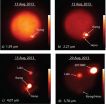(Press-News.org) Cambridge, Mass. – August 4, 2014 – A team of engineers at the Harvard School of Engineering and Applied Sciences (SEAS), Schlumberger-Doll Research Center in Cambridge, Mass., and the University of Texas, Austin, have created a truly portable device for nuclear magnetic resonance (NMR) spectroscopy.
NMR spectroscopy is a technique that perturbs protons within a molecule to glean important clues about its structure. It can identify unknown substances, detect very slight variations in chemical composition, and measure how molecules interact, making it an essential tool in organic chemistry, structural biology, and drug discovery, as well as for quality control in many industries.
Led by Donhee Ham, Gordon McKay Professor of Electrical Engineering and Applied Physics at Harvard SEAS, and his student Dongwan Ha, Ph.D. '14, the team has dramatically shrunk the electronic spectrometer components, fitting them on a silicon chip smaller than a sesame seed. Combined with a compact permanent magnet, this minuscule spectrometer represents the smallest device that can presently perform multidimensional NMR spectroscopy—a process Ham calls "one of the most powerful analytical tools to determine molecular structures at atomic resolution."
Significantly reducing both the size and cost of the device—while also preserving the broad functionality of much larger spectroscopy setups—now enables the development of portable NMR spectrometers that could travel to remote sites for online, on-demand applications or simply to laboratories where massive, state-of-the-art systems would be prohibitively expensive. The chips can also operate accurately over a wide temperature range.
A paper demonstrating the use of this silicon-based chip with a compact permanent magnet will be published online this week in Proceedings of the National Academy of Sciences (PNAS).
"State-of-the-art NMR systems use very large superconducting magnets, and they are indeed necessary for probing the structure of complex molecules like proteins," says Ham. "But in many circumstances—for example, many experiments in biochemistry or organic chemistry, quality control in production lines, or chemical reaction monitoring—you're doing NMR on smaller molecules, and for those applications the big superconducting magnets may be avoided."
Permanent magnets, which have been made much smaller in recent years, are weaker than superconducting magnets but still adequate to resolve small-to-medium size hydrocarbons, drug compounds, and biomolecules such as metabolites and amino acids. The advent of these smaller magnets motivated Ham's team to try to miniaturize the electronic components of the spectrometer. Those components include the transmitter and receiver for radio-frequency signals that orchestrate complex proton motions and monitor the telltale responses that reveal the quantum-mechanical details of molecular structure.
In comparison to superconducting magnets, however, permanent magnets are far less stable. With slight changes in temperature, the magnetic field fluctuates and drifts—a severe challenge that accompanies the system miniaturization. Ha, who is the main architect of the silicon spectrometer chip and lead author of the paper in PNAS, overcame the thermal problem with a distinctly modern tactic.
"Not only did Dongwan design the chip, but he also came up with a way to use statistical distance minimization and entropy minimization to estimate the magnetic field drift and calibrate out its effect," explains Ham. "This signal-processing method obviates the need for physical thermal regulation for the permanent magnet, which would have added hardware and increased the power consumption. That would have defeated our aim of achieving portability."
While Ham and Ha demonstrated the tiny spectrometer chips for portable applications with the permanent magnet, they also see potential for a completely different application in conjunction with a larger superconducting magnet. The chips, they say, could one day be assembled into a massively parallel array in a superconducting magnet bore to tremendously accelerate analysis of complex molecules by performing many NMR spectroscopy experiments at once.
"An individual NMR spectroscopy experiment is inherently slow, taking several minutes to hours," says Ham. "Using a hundred of these cheap and small spectrometer chips in parallel within a superconducting magnet bore could counter the intrinsic slowness of NMR spectroscopy, enabling a high-throughput paradigm for pharmaceutical screening and structural biology. One year of testing could be completed in a few days. We have already started investigating this angle."
The research team has filed for a provisional patent on the miniature NMR spectrometer, and they are exploring avenues for commercialization with Harvard's Office of Technology Development (OTD).
"We see a strong opportunity to commercialize the IP that's emerged from this work," says Sam Liss, Director of Business Development in OTD. "The feedback has been very positive from pharmaceutical companies involved in drug discovery, as well as from companies poised to deliver next-generation instrumentation for spectroscopy applications."
INFORMATION:
Coauthors of the paper in PNAS included Jeffrey Paulsen and Yi-Qiao Song at Schlumberger-Doll Research Center and Nan Sun at the University of Texas, Austin. The research was supported in part by Schlumberger, Ltd., the Air Force Office of Scientific Research (FA9550-13-1-0211), and the Office of Naval Research (N00014-13-1-0806).
Minuscule chips for NMR spectroscopy promise portability, parallelization
Two-by-two-millimeter spectrometer dramatically shrinks footprint for multidimensional analysis of molecules
2014-08-04
ELSE PRESS RELEASES FROM THIS DATE:
The evolution of migration
2014-08-04
Each year, millions of birds migrate thousands of miles between the locations where they breed and raise young, and the areas where they spend the winter. Each migration is a trip fraught with danger—many birds die before they reach their final destination. To scientists, long distance migration still holds many mysteries, one of which is: where did migration begin and how did it evolve? This question has long been a debated topic among scientists, but thanks to new research from Field Museum scientists, we may have an answer for one of the largest groups of migratory birds. ...
Flores bones show features of Down syndrome, not a new 'hobbit' human
2014-08-04
In October 2004, excavation of fragmentary skeletal remains from the island of Flores in Indonesia yielded what was called "the most important find in human evolution for 100 years." Its discoverers dubbed the find Homo floresiensis, a name suggesting a previously unknown species of human.
Now detailed reanalysis by an international team of researchers including Robert B. Eckhardt, professor of developmental genetics and evolution at Penn State, Maciej Henneberg, professor of anatomy and pathology at the University of Adelaide, and Kenneth Hsü, a Chinese geologist and ...
Triple therapy revs up immune system against common brain tumor
2014-08-04
A triple therapy for glioblastoma, including two types of immunotherapy and targeted radiation, has significantly prolonged the survival of mice with these brain cancers, according to a new report by scientists at the Johns Hopkins Kimmel Cancer Center.
Mice with implanted, mouse-derived glioblastoma cells lived an average of 67 days after the triple therapy, compared with mice that lasted 24 days when they received only the two immunotherapies. Half of the mice who received the triple therapy lived 100 days or more and were protected against further tumors when new cancer ...
African American professional women positive on medical research
2014-08-04
ROCHESTER, Minn. — If a research survey of African American professional women is any indication, attitudes may be changing towards participation in medical research. Mayo Clinic and The Links, Incorporated researchers teamed up to survey members of the international women's organization, and found that a majority of African American women surveyed are willing to or have taken part in medical research. The results appear in the Journal of Women's Health.
"Our findings are highly encouraging," says Sharonne Hayes, M.D., Mayo Clinic cardiologist, co-author of the study, ...
Fires in California and Oregon
2014-08-04
The Little Deer fire in California began as a lightning strike on July 31, 2014. Currently it has burned 4,700 acres and is 43% contained however there has been increased humidity over the fire the last 24 hours with shifting wind conditions. The threat of thunder storms today (08/04) and tomorrow (08/05) may cause an increase in fire activity.
The Beaver Complex is comprised of the Salt Creek Fire (20 miles northwest of Medford) and the Oregon Gulch Fire (15 miles east of Ashland), which are lightning-started fires that started on July 30-31, 2014. After it was first ...
Eiler and Bald Fires in California
2014-08-04
The Eiler wildfire which began on July 31, 2014, has almost consumed 26,000 acres. It is currently unknown as to the cause of this fire. The weather patterns currently around this fire do not bode well for a quick containment. Maximum temperatures are in the mid- to high 80's with 10-20% relative humidity. There is an unstable atmosphere at work along with thunderstorm chances which are increasingly today (08/04) through Wednesday (08/06). A Red Flag Warning in effect for dry lightning on Monday (08/04).
The Bald Fire began with a lightning strike on July 30, 2014. ...
Smoke from Canadian wildfires over Baffin Bay
2014-08-04
Canadian wildfires have been raging this summer and some of the smoke from those fires already drifted downward into the U.S. over the Great Lakes (see the image feature from July 25 below). In this image collected by the Moderate Resolution Imaging Spectroradiometer (MODIS) aboard the Aqua satellite on August 02, 2014 the large swath of smoke from these fires has taken a northward track and settled over the Bay of Baffin which borders Greenland.
To view the other Canadian fire images from July 2014:
Smoke from Canadian Fires Hovers Over Great Lakes - July 25, 2014
Smoke ...
Wildfires consume parts of eastern Russia
2014-08-04
Wildfires in far eastern Russia dot the landscape and what isn't covered by the fires is covered by the smoke that rises from these wildfires. This image taken by the Terra satellite shows the entire area covered with a blanket of heavy smoke coming off of dozens of wildfires that have broken out in the remote areas of Russia. Usually these fires are caused by lightning strikes that then consume the dry vegetation. With nothing to stop the spread, these fires take off and cover the landscape, especially during this time of year.INFORMATION:
NASA's Terra satellite collected ...
A hellacious two weeks on Jupiter's moon Io
2014-08-04
Three massive volcanic eruptions occurred on Jupiter's moon Io within a two-week period last August, leading astronomers to speculate that these presumed rare "outbursts," which can send material hundreds of miles above the surface, might be much more common than astronomers thought.
"We typically expect one huge outburst every one or two years, and they're usually not this bright," said Imke de Pater, professor and chair of astronomy at the University of California, Berkeley, and lead author of one of two papers describing the eruptions. "Here we had three extremely ...
Single-fraction RT as effective as multiple-fraction RT for palliation of bone metastases
2014-08-04
Fairfax, Va., August 4, 2014—Standardizing prescribing practices for single-fraction radiation therapy (SFRT) for palliation of bone metastases could lead to cost savings and improvement in patients' quality of life, according to a study published in the August 1, 2014 edition of the International Journal of Radiation Oncology • Biology • Physics (Red Journal), the official scientific journal of the American Society for Radiation Oncology (ASTRO).
Bone metastases are a common manifestation of distant spread of disease, occurring most frequently with prostate, breast ...
LAST 30 PRESS RELEASES:
Scientists use ultrasound to soften and treat cancer tumors without damaging healthy tissue
Community swimming program for Black youth boosts skills, sense of belonging, study finds
Specific depressive symptoms in midlife linked to increased dementia risk
An ‘illuminating’ design sheds light on cholesterol
Who is more likely to get long COVID?
Study showcases resilience and rapid growth of “living rocks”
Naval Research Lab diver earns Office of Naval Research 2025 Sailor of the Year
New Mayo-led study establishes practical definition for rapidly progressive dementia
Fossil fuel industry’s “climate false solutions” reinforce its power and aggravate environmental injustice
Researchers reveal bias in a widely used measure of algorithm performance
Alcohol causes cancer. A study from IOCB Prague confirms damage to DNA and shows how cells defend against it
Hidden viruses in wastewater treatment may shape public health risks, study finds
Unlock the power of nature: how biomass can transform climate mitigation
Biochar reshapes hidden soil microbes that capture carbon dioxide in farmland
Reducing saturated fat intake shows mortality benefit, but only in high-risk individuals
Manta rays create mobile ecosystems, study finds
Study: Mixed results in using lipoic acid to treat progressive multiple sclerosis
Norbert Holtkamp appointed director of Fermi National Accelerator Laboratory
New agentic AI platform accelerates advanced optics design
Biologists discover neurons use physical signals — not electricity — to stabilize communication
Researchers discover that a hormone can access the brain by hitchhiking
University of Oklahoma researcher awarded funding to pursue AI-powered material design
Exploring how the visual system recovers following injury
Support for parents with infants at pediatric check-ups leads to better reading and math skills in elementary school
Kids’ behavioral health is a growing share of family health costs
Day & night: Cancer disrupts the brain’s natural rhythm
COVID-19 vaccination significantly reduces risk to pregnant women and baby
The role of vaccination in maternal and perinatal outcomes associated with COVID-19 in pregnancy
Mayo Clinic smartwatch system helps parents shorten and defuse children's severe tantrums early
Behavioral health spending spikes to 40% of all children’s health expenditures, nearly doubling in a decade
[Press-News.org] Minuscule chips for NMR spectroscopy promise portability, parallelizationTwo-by-two-millimeter spectrometer dramatically shrinks footprint for multidimensional analysis of molecules






